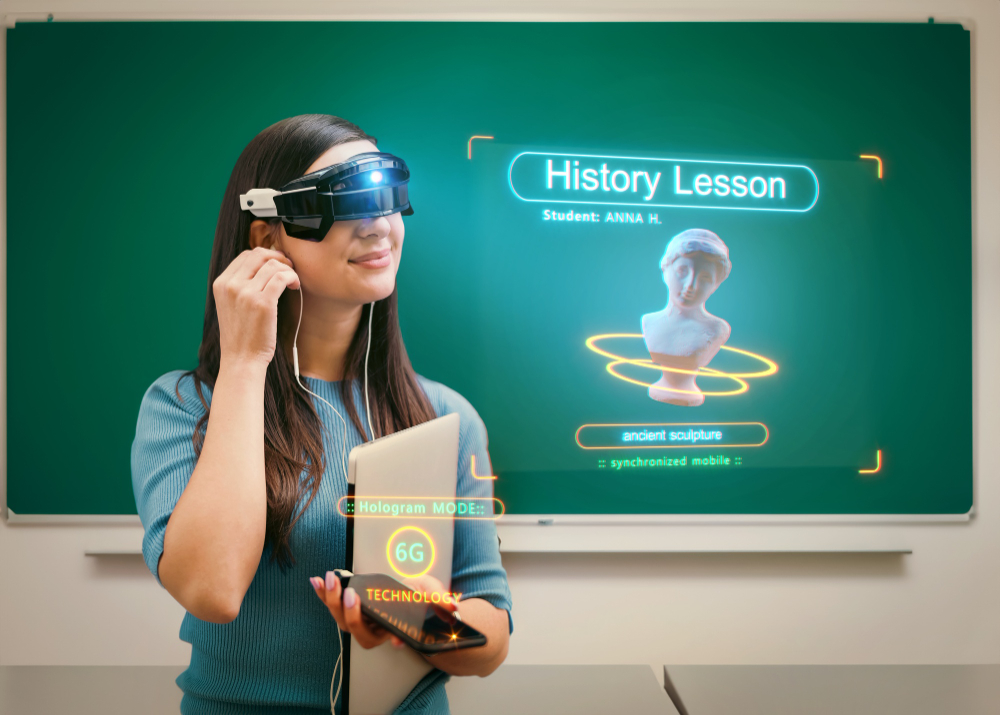Application of Digital Innovation in Higher Education
- 1 The concept of digital transformation in education
- 2 Benefits of digital transformation
- 3 Important points in the development of digital innovation
- 4 Conclusion
- 4.1 FAQs:
- 4.1.1 What is digital transformation in education?
- 4.1.2 What are some examples of digital innovations in education?
- 4.1.3 How does digital transformation benefit students?
- 4.1.4 How do universities benefit from digitalization?
- 4.1.5 What are some challenges associated with digital transformation in education?
- 4.1.6 How can universities adapt to digital transformation?
- 4.1.7 What are the key areas affected by digital transformation in universities?
- 4.1.8 How does digital transformation impact the future of education?
- 4.1.9 What role does innovation play in digital transformation in education?
- 4.1.10 How can students benefit from digital innovations in education?
- Enhanced Learning Experience: Digital transformation in education improves teaching methods, enhances subject perception, and provides flexible learning options like blended learning and interactive resources.
- Accessibility and Inclusivity: Digital innovations make education accessible to all, including those with disabilities, by offering online platforms for learning from anywhere in the world.
- Efficiency and Cost Savings: Digitalization streamlines educational processes, reduces the need for physical resources like textbooks, and enables institutions to manage budgets more efficiently, potentially opening up new opportunities for scholarships and investments
Digitalization is changing the ways how universities organize their administration, share knowledge, and create and transfer new knowledge in research. It permeates all structures, places, formats, and purposes of research, education, and learning and is changing critical skills for the working world of tomorrow.
The goal of digital change is to improve the teaching system. Thanks to innovation, it is possible to change the presentation of information and its perception. Students will be able to see the subject from a different perspective. With blended learning, it is possible to understand a particular topic in more detail and have more free time. Recorded webinars can be replayed several times, or a speaker can be chosen to suit the student’s needs. Interactive games and various tests affect the memorization of the material covered. In this area, digital transformation is essential in improving general perception and understanding of subjects.
With digital proof of performance, e.g., videos, you can simultaneously test and work on specific individual skills and specialized topics. A relaxed and open approach to digital media on the teaching side seems beneficial: if expectations for technical implementation are lower and students receive individualized support, potential excessive demands are counteracted. Furthermore, such experimental spaces represent low-threshold opportunities to acquire media skills that future professionals can then put into practice with similar efforts and goals.
The concept of digital transformation in education
Digital transformation is no longer a new concept in education. Different innovations have been introduced over the last five years to improve education. In the global sense, digital transformation implies introducing innovative methods of presenting information, processing student work, etc. It is essential to help students learn in the most comfortable and practical conditions. Lately, new platforms for learning have been introduced. This allows students to receive any education regardless of where they live. At the same time, it is helpful if physical face-to-face lessons use didactic tools that promote interaction and are an extension of previous digital exchanges. This form of blended learning opens up new opportunities for students. Now, it is possible to learn the material even better, understand different topics, etc. What innovations are most often introduced in the training field?
- Combined Learning Option – Here, online platforms are used as help. These can be recorded webinars or online assignments. The student can work through the material independently and then complete the project as a test to consolidate the information.
- Platforms that help you get through your coursework quickly – These can be resources for checking the uniqueness of the text, a quick search on a given topic of information, citations, and so on.
- Services with professionals who can write my essay and other tiring tasks you do not have time for. Afterwards, you can use their work as an inspiration to improve and learn.
- Interactive resources that allow you to complete the material playfully – This is especially relevant for those who need help to memorize the standard version of the information presentation. These can be interactive cards, games, and so on.
Thanks to digital innovations in education, everyone can learn, especially if a person has health problems or disabilities preventing them from leaving home. Interactive platforms make it possible to study subjects online. Students participate in live online webinars, complete assignments and tests, and then receive an assessment of their work.
Benefits of digital transformation
Digital transformation is a labour-intensive process. It will take several more years to achieve the desired success in various institutions. But several significant benefits come with the full implementation of innovation in education:
- First and foremost, it is an educational opportunity for all people, even those with disabilities.
- It is possible to study on interactive platforms from anywhere in the world. All webinars are online, and afterwards, you can take a test and get an assessment of the result.
- Another significant plus is saving money. Thanks to electronic media, there is no need to spend on textbooks, notebooks, and so on. Everything is now available electronically.
Educational institutions have an opportunity to manage their budgets more rationally. It may be possible to open new scholarship places for students. Or they can invest in projects or charity. Digital innovation is a new stage in the development of human beings in various fields. Educational institutions need to be able to increase the efficiency of information and its perception by students and to expand the possibility of higher education for all students from all corners of the world.
Important points in the development of digital innovation
Digitalization will be helpful not only to students. In addition to using appropriate sophisticated campus management systems, universities need robust document management systems for processing and long-term storage of digital documents (student files, exam files, etc.) and technical requirements for connecting to government portals (including developing authentication solutions). It is not only data centres that are in demand, but within universities at all levels, there is a need to create awareness that the upcoming digital changes will affect all areas of university operations.
Understanding this as a challenge and an opportunity simultaneously and facilitating university change appropriately will be the task of university management, who will have to develop viable solutions for their university, even if difficulties or conflicts arise. To this end, suitable governance structures should be implemented with the most important stakeholders, not only in the universities. Collaboration with inter-university initiatives can also make a decisive contribution to overcoming challenges in universities related to the expansion of e-government.
Digitalization naturally requires universities to make specific structural changes. Everything falls into this category, from optimizing university websites to improving marketing strategies and structurally expanding lecture rooms.
Conclusion
In conclusion, digital transformation is revolutionizing the landscape of education by offering innovative solutions to enhance teaching methodologies, improve accessibility, and streamline administrative processes within academic institutions. Through digital innovations such as blended learning, interactive resources, and online platforms, students now have unprecedented opportunities to engage with course materials, collaborate with peers globally, and receive personalized support for their learning needs.
Furthermore, universities stand to benefit from increased efficiency, cost savings, and expanded outreach to a diverse student population. While challenges such as structural changes and resistance to technological advancements may arise, embracing digitalization is essential for ensuring the relevance and effectiveness of education in the digital age. By embracing digital transformation, universities can position themselves at the forefront of educational excellence and prepare students for success in the dynamic, technology-driven world of tomorrow.
FAQs:
What is digital transformation in education?
Digital transformation in education refers to the integration of technology and innovative methods to enhance teaching, learning, and administrative processes within academic institutions.
What are some examples of digital innovations in education?
Examples include blended learning options, interactive learning resources, online platforms for coursework, and services for academic support tasks.
How does digital transformation benefit students?
It offers enhanced learning experiences, accessibility to education regardless of location, and potential cost savings on resources like textbooks.
How do universities benefit from digitalization?
Universities can streamline administrative processes, manage budgets more efficiently, and improve outreach to a broader student population.
What are some challenges associated with digital transformation in education?
Challenges may include the need for structural changes, ensuring inclusivity and accessibility, and overcoming resistance to technological changes.
How can universities adapt to digital transformation?
Universities can invest in robust digital infrastructure, develop suitable governance structures, and collaborate with inter-university initiatives to facilitate change effectively.
What are the key areas affected by digital transformation in universities?
Areas include teaching methods, administrative processes, document management, and structural changes within the institution.
How does digital transformation impact the future of education?
It offers opportunities for enhanced learning experiences, improved accessibility, and more efficient management of educational resources.
What role does innovation play in digital transformation in education?
Innovation drives the development of new teaching methods, learning resources, and administrative solutions to improve the overall educational experience.
How can students benefit from digital innovations in education?
Students can access learning materials from anywhere, engage in interactive learning activities, and receive personalized support for their academic needs.




















Your blog post on education is incredibly insightful and resonates deeply with my own experiences. The emphasis on fostering a love for learning and critical thinking is crucial in today’s rapidly changing world. I appreciate how you highlight the importance of personalised learning and adapting teaching methods to cater to diverse learning styles.
growthcentre.org